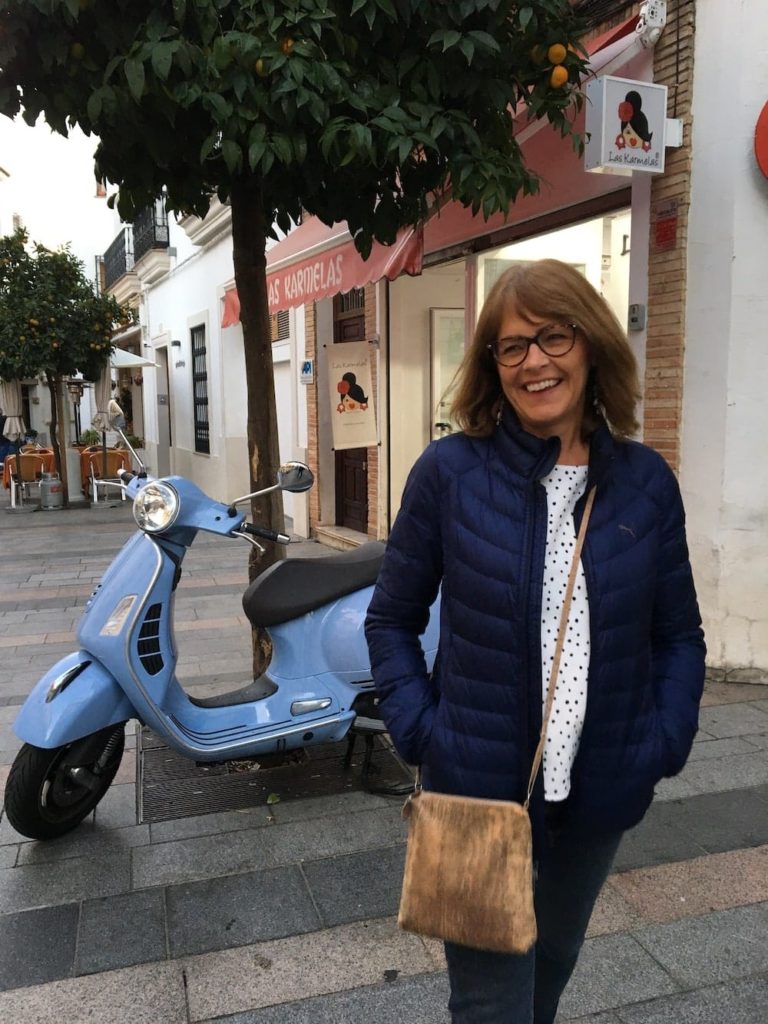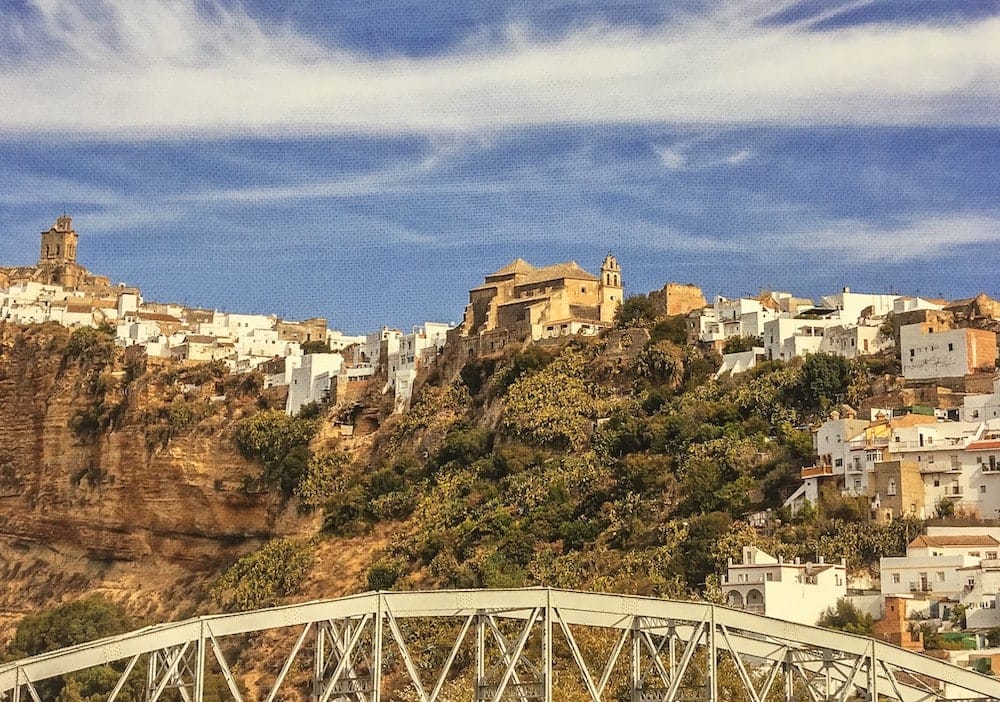
The bright, ripe oranges in green trees glistened in the rain and alternated with the grey-greens of olive orchards as we drove on the slow road from Cordoba to Seville. We chose this path because it would take us past the majestic hillside castles and walled towns like Almodovar del Rio and Arcos de la Frontera, towering impressively over the plains. The latter town was literally a ‘frontier’ town, built by the Moors when invading Spain, and perched on top of an enormous cliff in the middle of a river plain. All the better to spot the enemy. We stopped by at lunch time and could glimpse the interior courtyards of the tiny, white-washed houses on the steep slopes, smell the fish stew simmering on the stove tops, and occasionally spot the very 1950s-looking interiors. The castle in Arcos de la Frontera is privately owned. I hate to think what it is like to live in this great, gloomy stone building, let alone the cost of upkeep.
Our Airbnb in Seville was on the South side of the river, in the Triana district. We were in a small, converted law office, complete with deep, dark-wood fitted shelves, a board-room and reception area. I half expected a bespectacled receptionist to appear and say: “This way, Senora, Senor Jorge will be with you shortly” as I wandered into the office kitchen to make a cup of tea. The area was typically Spanish, mostly small shops, bars and restaurants. They all appear to be locally owned, and the shopkeepers must have been there for generations and keep traditional hours. Shopping is how I remember it from High Street England when I was growing up; you go from the fishmonger to the butcher to the newsagent and occasionally the ironmonger when you need a battery or something. Small covered food markets sell beautiful fresh food and tapas. The tapas were delicious; second only to those of San Sebastian and Bilbao. We found a place on our side of the river called Tipico, and went there twice, standing room only, to eat characteristic Sevillian tapas: beef cheeks, oxtail, suckling pig.
Triana is quite trendy now, but until the 1950s it was a working-class industrial area where they used clay from the river banks from Roman times to make pottery and then ceramics. The excellent Triana Ceramics Centre, built in part of an old factory, took us through the evolution of the art; filling in the information we missed in the mad dash around the Ceramics Museum in Valencia. For former sign makers, the creation of ceramic signs was interesting (see picture). The graphics/pictures are hand-painted onto the ceramic tiles, and the pattern makers and painters were skilled craftspeople.
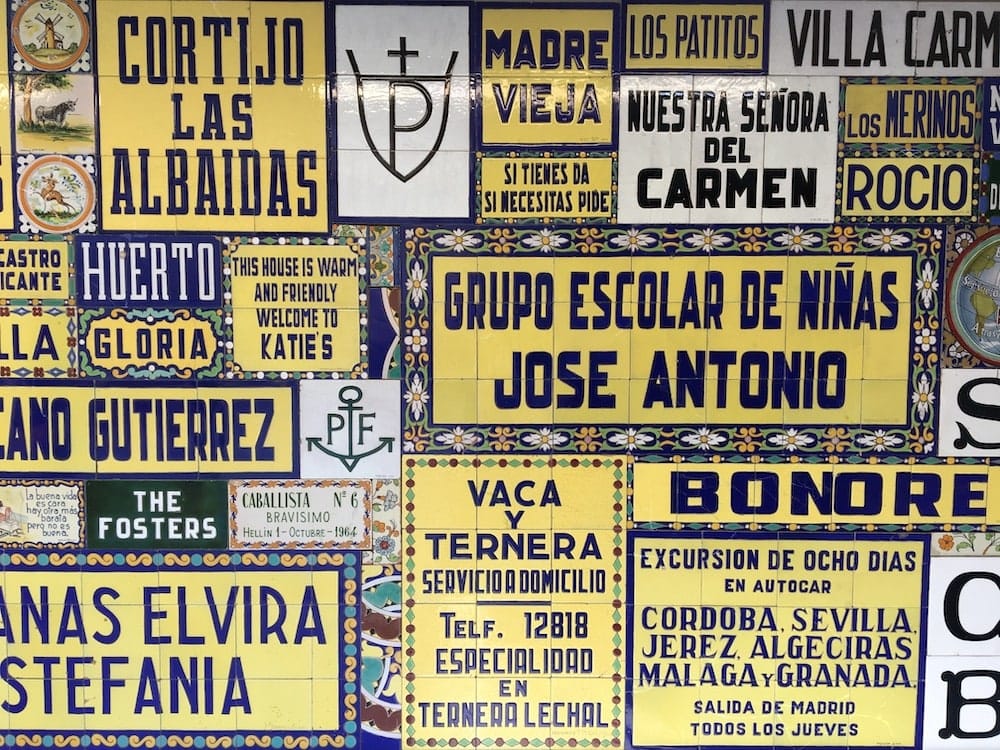
The weather was getting colder, but this did not stop Sevillians from spending their lunchtimes and evenings promenading the pedestrian streets, stopping for beer and tapas, shopping on foot with their designer shopping carts. As the clothing got heavier, I noticed a curious fact; middle-aged men wear brightly coloured cords or trousers and/or light cashmere sweaters in any colour of the rainbow. The women, on the other hand, tend to be dressed head to toe in different shades of one colour. If the main colour group is brown, they might have dark brown pants, brown boots, a rusty-brown sweater and a beige patterned scarf. It’s either brown, blue, green, grey/black, or occasionally and startingly – various shades of pink. They look very elegant, but it’s as if they went to Benjamin Moore and got a colour chart and went clothes shopping with it, working their way from ‘Sienna Clay’ to ‘Falcon Brown’. I wondered if maybe they have a ‘blue’ day and then a ‘green’ day, but that would get expensive once you get into jacket season, so I believe you pick a colour and stick with it. If you forget someone’s name, I suppose you could say: “Oh, what’s-her-name, she’s purple.” and everyone would know who you meant. Young female Spaniards dress in jeans and t-shirts like universal young people. Is there a point in your early forties in Spain where your mother says: “Right dear, you’ve got 2 kids and a good career, it’s now time to ditch the multi-coloured outfits and go monochrome; I’ll take you shopping on Saturday. I think Forest Green would suit you.”?
The river is the same one which flows fast and wide through Cordoba, the Guadalquivir. It is the key to Seville’s importance, as it is the only one in Spain which is navigable. It flows into the Atlantic Ocean, and this river is used. There’s a sizeable commercial port, ships heading across the Atlantic were outfitted here, and the river is busy with ferry boats, pleasure tours, cruise ships and rowing teams from the local club practised every evening. The bridges over the river are beautiful and always busy with foot-traffic.
You can visit the privately owned Seville Bull Ring for a tour. The season for bullfights is Easter through to the fall, not that it disappointed us to miss them. Indeed, our guide, who knowledgeably told us about how bullfighting developed from military exercises with lances, admitted to never having seen a bullfight. “I am Sevillian” she said: “I respect the bullfight; I would never go to one”. Bullfighting has been banned in Catalonia, but here Sevillian families buy season tickets and will pay 100 Euros a seat. There is a Royal box. A museum displayed the stuffed heads of famous fighting bulls, including one which fought so well that they spared its life, and it died in pasture. The bulls are butchered after they are killed, the matadors patched up in the built-in medical clinic and occasionally prayed over in the chapel where they stopped by before the fight. The bullfighters are like football stars, but as agility and accuracy are more important in their sport than in either soccer or American football, they are small. Their elaborate gold-threaded costumes look tiny.


We crossed off going to a bull ring from the list of things to do in Spain, and in the elegant Place D’Espana, built for the World Exhibition in 1929, we finally saw flamenco troupes performing. These were professionals – they spend years studying their art – and I hadn’t realized that they improvise. The guitarist and singer watched the dancer attentively and took cues from the speed and intensity of her dancing. It’s a whole-body thing. You can see the energy rising from toe to head of the dancer and out through her fingertips, the singer’s throat straining with the grating song, the guitar strings vibrating faster and faster. All of it with intense scowls on the faces of the performers.
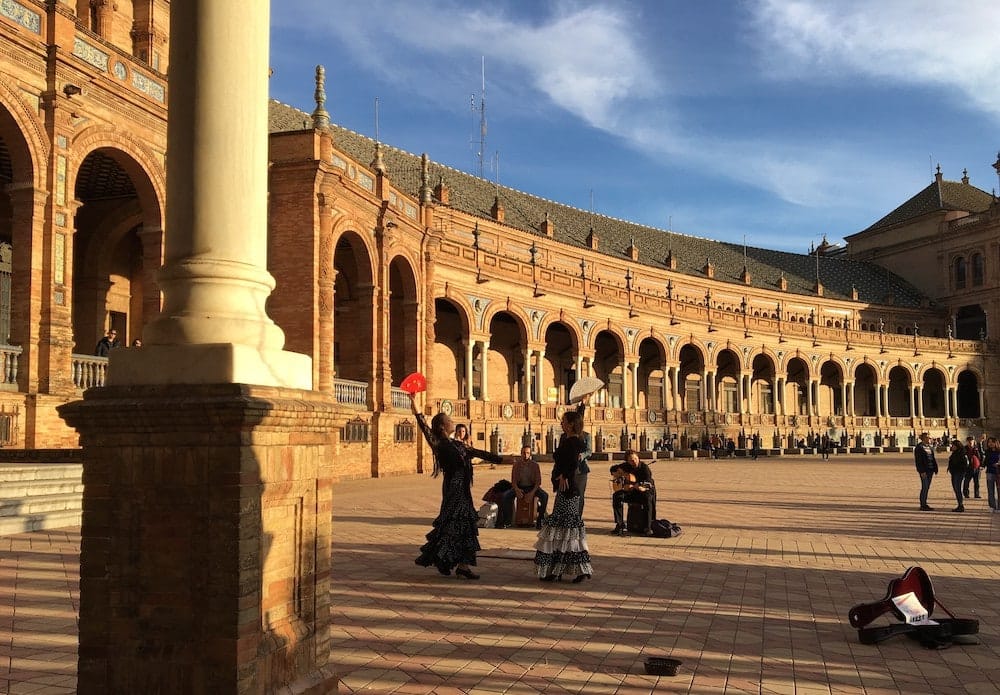
Some of Seville was disappointing. A new structure named The Setas flows over a central square and gives you a view of the city, but I can see why its architecture is controversial. Some of Seville was unexpected. The former Royal Tobacco Factory is now part of the University of Seville, and is a huge, fascinating building of courtyard after courtyard, the stables, weighing stations, areas to dry tobacco and counting houses still there and marked for their original purpose. It was here that Spanish women first joined the industrial revolution’s workforce in significant numbers. The character of Carmen in Bizet’s opera was a tobacco factory worker. Students were weaving through the courtyards, going to and from lectures with quiet purpose where 150 years ago the wagons rattled on the stone, the clocks rang out the quarter hour, and the workers called and chatted to each other. If caught stealing tobacco, they were locked up in the on-site prison.

Seville has the requisite old quarters of narrow winding streets, filled with tourist shops and bars. Of course, it also has an impressive Seville Cathedral, this one mostly built over the big mosque, rather than from within it, which we saw in Cordoba. It was huge, and we spent an entire afternoon looking at the tomb of Columbus, and climbing the Grimalda, the former mosque minaret which the muezzin would climb on a mule five times a day to call the faithful to prayer. Equally huge was the Alcazar, the Royal fortress and palace. As in Granada, this was a Moor structure taken over by the Christian Kings when they conquered Seville. It’s famous for the beautiful gardens, rows and rows of myrtle hedges, fountains, orange groves and a curious clock fountain which plays a tune on the hour by water flowing through pipes. There were a fair number of British visitors in Seville, and as they left the elegant arbours in sensible sandals (all the Europeans were in shoes and socks – it was late November!) MLH and I made bets about which ones would say: “Lovely gardens!” first.
On our last day in Spain it rained, and we didn’t go far. That gave me a chance to think about our whole trip and Spain in particular. I think the best way to summarize my ‘Sketches of Spain’ is this list I made:
The best businesses in which to invest in Spain
Baby accessories There seem to be a tremendous number of twins (leaving parenthood until later? Fertility issues?). Double baby strollers with all the gadgets which do all but change the babies for you were on every street. They probably cost more than my car.
Fertility drugs (see above)
Children’s fancy clothes On Sundays, siblings are dressed smartly in matching clothes; sometimes -creepily– the mother’s clothes will match as well. Perhaps it makes it easier for the father to keep everyone together. Little girls wear frilly dresses and enormous, bountiful bows in their hair.
Wheeled shopping carts Everyone has one of these, at least in the inner cities where most people do not own a car, and they use them every day. You cannot take them in to the small city supermarkets, so you have to chain them up at special stands, where they wait while you do your shopping like horses at an Old West hitching post. I thought, naively, that all shopping carts were the same; not so. Some have freezer sections in the front to keep your frozen food frozen. Some have intricate pockets for your fan, lock, purse, and glorious sections and zippers which make a high-school student’s designed-for-electronics backpack look like a tote bag.
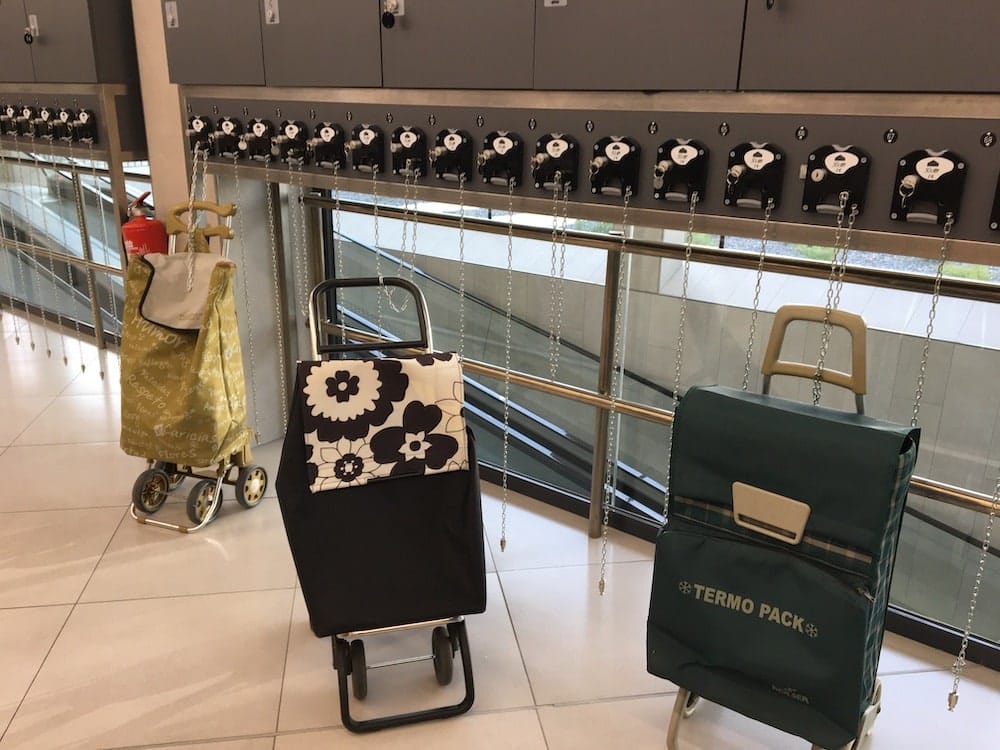
Jamon (ham) Eaten every day as far as I can tell. It’s in everything. At Christmas people buy expensive ($100-200) cured ham hocks, put them in a special holder on the kitchen counter, and take lessons in how to carve them.
Tabaco Well, you know all about that from my Madrid post, so I’ll say no more.
Hair colour During two months in Spain, I saw perhaps ten ladies who had let their hair go grey. As the sun is strong and people are outside much of the time, many seniors have deep, deep wrinkles and tanned faces. It’s always a bit of a shock to see brunette Clairol hair haloing a 90-year-old face. A surprising number of younger Spanish women are bottle blonds. Come to think of it, add Hair Salons to this list. It must be a good business to be part of in Spain.
So that’s Southern France and Spain through my eyes and the end of Nestless and Restless Season 2. We left Seville for England at the end of November, happy to not have to settle in to yet another unfamiliar flat and unpack again, but also looking forward to the next trip…. Thank you for travelling with me through this blog. It’s good to have company. Until next time – hasta luego!
Elizabeth
England, November 2018
